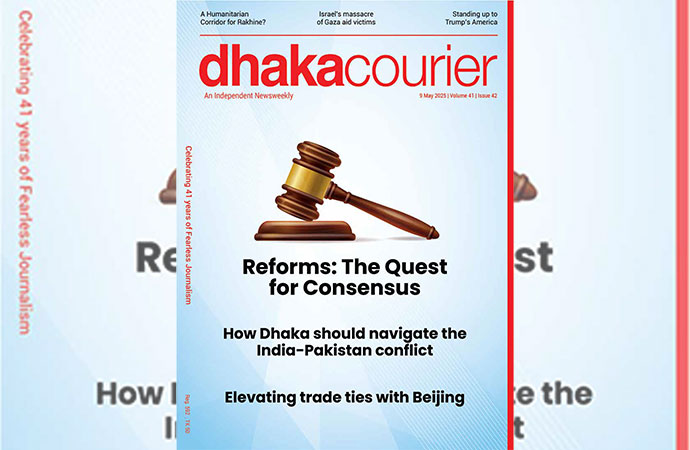Reportage






With the daily infection rate, or positivity rate - i.e. the proportion of tests returning a positive result - for COVID-19 hovering between 2.3-3.3 % throughout February, confirmed cases falling to the hundreds and a much-vaunted vaccination campaign well underway, Bangladeshi authorities felt confident enough towards the end of the month to announce that schools and other educational institutions in the country would be reopening from March 30.
The authorities could hardly be blamed for that. The multifaceted nature of the disruption to family life posed by school closures means that in many ways the ability to reopen schools safely stands as the ultimate sign of a government succeeding at overcoming the virus. Naturally they would be keen on proving so, and by and large they had the public's support in this case.
Little could they have foreseen the subsequent spike that has been witnessed since the start of March. In the first week of March, Bangladesh reported 4,114 new cases, an increase of 43.6% compared to the last week of February.
The daily infection rate hit 4.3% on March 1, then dipped below 4% again, before nudging up to 4.6% on March 5, and hit 5% for the first time on March 9. On March 11, the first anniversary of the WHO declaring COVID-19 a pandemic, the infection rate had remained above 5% for three consecutive days for the first time this year. More than 1,000 new cases of infection were reported in the daily count on Wednesday and Thursday for the first time in two months. The hospitalisation rate has spiked as well.
Health experts say people's reluctance to follow the rules has led to the rise in daily numbers. Many people are attending social gatherings, flocking to popular tourist destinations, and going about daily activities as if the pandemic is over, they added.
The rush of holidaymakers seen flocking at Cox's Bazar over the long weekend brought about by the International Mother Language Day, or Language Movement Day on February 21, made the medical experts particularly wince.
Health Minister Zahid Maleque on March 11 urged the people to beware, as the Covid-19 infection rate was increasing again.
"Lately, the rate of infection has increased. The situation will deteriorate if we don't wear masks and maintain social distancing rules," he told reporters after an event at the National Institute of Ophthalmology and Hospital in the capital.
Maleque expressed concerns over people visiting tourist spots and arranging social events without maintaining any health protocols. He said that the government is prepared to tackle any situation and has sent administrative instructions across the country to avoid public gatherings, ensure the use of masks and vaccination.
"No one should think they are immune from coronavirus after taking the first dose of vaccine. It's only after the second dose that the vaccine starts becoming effective," he added.
Maleque said the health department is working to bring 80 percent of the country's people under vaccination in phases. The third shipment of the vaccine purchased from the Serum Institute of India will arrive this month. Moreover, 10.9 million doses under the WHO and GAVI-run Covax facility are expected to arrive in phases by June.
The health minister said the government plans to vaccinate teachers, staff and students before the educational institutions reopen in late March. Already the murmurs have started that the reopening may have to be put off again.
More than bad behaviour?
It is true that the public has in recent weeks increasingly returned to previous ways - not wearing masks, little regard for social distancing, most commercial outlets opening - but can the resurgence be attributed to behavioural reasons alone?
On March 10, we learned that the highly contagious UK variant of the coronavirus has been present in Bangladesh since January, with the officials only choosing to finally make it public now, as the country braced for a possible surge in COVID-19 cases and positivity rate. Although most people may have guessed this, given that people have continued to arrive from the UK throughout the last three months, but the official word surely counts for something.
Directorate General of Health Services director general ABM Khurshid Alam told reporters that the UK variant has been present in the country since January, but "there is no conclusive findings on it yet if the variant is responsible for the surge in COVID-19 cases and positivity rate in the past few days."
The government's disease monitoring arm - the Institute of Epidemiology, Disease Control and Research, or IEDCR - said that people becoming indifferent towards following health practices like wearing masks had most likely been the cause behind the rise in the number of cases in recent days.
"We have found no infection with the UK variant among the families and people who came in contact with the six patients detected in January after they had arrived in the country from the UK," said IEDCR principal scientific officer ASM Alamgir.
There can be no telling though, that they didn't spread the virus. These cases most likely date back to a strange episode in late January, when it was reported that 28 UK returnees had tested positive for Covid-19 upon completing institutional quarantine, and were taken into institutional isolation at a hospital in Sylhet.
A flight of Biman Bangladesh Airlines carrying 157 passengers from London landed in Sylhet's Osmani International Airport on January 21, said the police official.
As per the instruction of the Health Ministry, they were put under institutional quarantine at different hotels for four days. Upon completion of their quarantine, their samples were sent for Covid-19 PCR tests on Sunday and 28 of them tested positive. Among the 28 infected persons, 15 had stayed at Hotel Noorjahan while five at Hotel Britannia, four at Hotel Holy Gate, three at Hotel La Rose and one at Hotel Holy Side. After their test reports came out positive, they were isolated and taken to the 31-bed Khadimpara Hospital, a dedicated isolation centre for Covid-19 patients in Sylhet.
Just a day later though, their samples were sent to the Shahjalal University of Science and Technology lab, and there 25 of the 28 samples that originally tested positive for COVID-19 came out negative. Meanwhile a specialist team of the IEDCR arrived in Sylhet to carry out further tests on these individuals. But the results of these further tests were never revealed.
The UK variant of the novel coronavirus, which various modelling exercises have estimated to be up to 70% more transmissible than the previously circulating form of the virus, was behind a surge of cases in December-January that lifted the death toll per capita in the UK in January to the highest in the world. In September, 2020, the variant represented just one in four new diagnoses of COVID-19, whereas by mid-December, this had increased to almost two thirds of new cases in London. UK Prime Minister Boris Johnson decided with his scientific advisors that he had no credible alternative other than to impose even stricter restrictions on those parts of England, mainly in the south-east, where the strain was found to be more prevalent, creating a new tier 4, which meant all non-essential shops and gyms closed, and people were asked to stay at home wherever possible (hospitality venues already had to close in tier 3).
Johnson later announced that the new strain was also potentially 30% more deadly than the original virus. A panel of scientists that advises the British government on the threat posed by emerging respiratory viruses concluded that there was a 1.3-fold increase in the risk of death, Neil Ferguson, an epidemiologist at Imperial College London who sits on the advisory body, told Britain's ITV News. Ferguson said that this meant that for every 1,000 people aged 60 who contracted the new strain of the virus, 13 would likely die, compared to 10 with the original strain.
A difficult anniversary
When the World Health Organization declared the coronavirus a pandemic one year ago Thursday, it did so only after weeks of resisting the term and maintaining that the highly infectious virus could still be stopped.
A year later, the U.N. agency is still struggling to keep on top of the evolving science of COVID-19, to persuade countries to abandon their nationalistic tendencies and help get vaccines where they're needed most.
The agency made some costly missteps along the way: It advised people against wearing masks for months and asserted that COVID-19 wasn't widely spread in the air. It also declined to publicly call out countries - particularly China - for mistakes that senior WHO officials grumbled about privately.
That created some tricky politics that challenged WHO's credibility and wedged it between two world powers, setting off vociferous Trump administration criticism that the agency is only now emerging from.
President Joe Biden's support for WHO may provide some much-needed breathing space, but the organization still faces a monumental task ahead as it tries to project some moral authority amid a universal scramble for vaccines that is leaving billions of people unprotected.
"WHO has been a bit behind, being cautious rather than precautionary," said Gian Luca Burci, a former WHO legal counsel now at Geneva's Graduate Institute. "At times of panic, of a crisis and so on, maybe being more out on a limb - taking a risk - would have been better."
WHO waved its first big warning flag on Jan. 30, 2020, by calling the outbreak an international health emergency. But many countries ignored or overlooked the warning.
Only when WHO Director-General Tedros Adhanom Ghebreyesus declared a "pandemic" six weeks later, on March 11, 2020, did most governments take action, experts said. By then, it was too late, and the virus had reached every continent except Antarctica.
A year later, WHO still appears hamstrung. A WHO-led team that traveled to China in January to investigate the origins of COVID-19 was criticized for failing to dismiss China's fringe theory that the virus might be spread via tainted frozen seafood.
That came after WHO repeatedly lauded China last year for its speedy, transparent response - even though recordings of private meetings obtained by The Associated Press showed that top officials were frustrated at the country's lack of cooperation.
"Everybody has been wondering why WHO was so praising of China back in January" 2020, Burci said, adding that the praise has come back "to haunt WHO big-time."
Some experts say WHO's blunders came at a high price, and it remains too reliant on iron-clad science instead of taking calculated risks to keep people safer - whether on strategies like mask-wearing or whether COVID-19 is often spread through the air.
"Without a doubt, WHO's failure to endorse masks earlier cost lives," said Dr. Trish Greenhalgh, a professor of primary care health sciences at Oxford University who sits on several WHO expert committees. Not until June did WHO advise people to regularly wear masks, long after other health agencies and numerous countries did so.
Greenhalgh said she was less interested in asking WHO to atone for past errors than revising its policies going forward. In October, she wrote to the head of a key WHO committee on infection control, raising concerns about the lack of expertise among some members. She never received a response.
"This scandal is not just in the past. It's in the present and escalating into the future," Greenhalgh said.
Raymond Tellier, an associate professor at Canada's McGill University who specializes in coronaviruses, said WHO's continued reluctance to acknowledge how often COVID-19 is spread in the air could prove more dangerous with the arrival of new virus variants first identified in Britain and South Africa that are even more transmissible.
"If WHO's recommendations are not strong enough, we could see the pandemic go on much longer," he said.
With several licensed vaccines, WHO is now working to ensure that people in the world's poorest countries receive doses through the COVAX initiative, which is aimed at ensuring poor countries get COVID-19 vaccines.
But COVAX has only a fraction of the 2 billion vaccines it is hoping to deliver by the end of the year. Some countries that have waited months for shots have grown impatient, opting to sign their own private deals for quicker vaccine access.
WHO chief Tedros has responded largely by appealing to countries to act in "solidarity," warning that the world is on the brink of a "catastrophic moral failure" if vaccines are not distributed fairly. Although he has asked rich countries to share their doses immediately with developing countries and to not strike new deals that would jeopardize the vaccine supply for poorer countries, none have obliged.
"WHO is trying to lead by moral authority, but repeating 'solidarity' over and over when it's being ignored by countries acting in their own self-interest shows they are not recognizing reality," said Amanda Glassman, executive vice president of the Center for Global Development. "It's time to call things out for the way they are."
Yet throughout the pandemic, WHO has repeatedly declined to censure rich countries for their flawed attempts to stop the virus. Internally, WHO officials described some of their biggest member countries' approaches to stemming COVID-19 as "an unfortunate laboratory to study the virus" and "macabre."
More recently, Tedros seems to have found a slightly firmer voice - speaking truth to leaders like Germany's president about the need for wealthy countries to share vaccines or criticizing China for dragging its heels in not quickly granting visas to the WHO-led investigative team.
Irwin Redlener of Columbia University said WHO should be more aggressive in instructing countries what to do, given the extremely unequal way COVID-19 vaccines are being distributed.
"WHO can't order countries to do things, but they can make very clear and explicit guidance that makes it difficult for countries not to follow," Redlener said.
WHO's top officials have said repeatedly it is not the agency's style to criticize countries.
At a press briefing this month, WHO senior adviser Dr. Bruce Aylward said simply: "We can't tell individual countries what to do."
Will the coronavirus ever go away?
No one knows for sure. Scientists think the virus that causes COVID-19 may be with us for decades or longer, but that doesn't mean it will keep posing the same threat.
The virus emerged in late 2019 and it's difficult to predict how it will behave over the long term. But many experts believe it's likely the disease will eventually ease from a crisis to a nuisance like the common cold.
That would happen as people build up immunity over time, either through infection or vaccination. Other viruses have followed a similar path.
The 1918 flu pandemic could also offer clues about the course of COVID-19.
The U.S. Centers for Disease Control and Prevention estimates that a third of the world's population became infected with that virus, which originated in birds. Eventually, after infected people either died or developed immunity, the virus stopped spreading quickly. It later mutated into a less virulent form, which experts say continues to circulate seasonally.
However, the emergence of new COVID-19 variants could complicate the picture if future virus mutations cause more severe disease or evade vaccines.
It's unlikely the virus will ever be completely stamped out, given the possibility that people might be able to get reinfected after they've already been sick or vaccinated.
The only virus that's ever been eradicated from the human population is smallpox. That's because people develop lasting immunity to that virus after getting sick or vaccinated.
Additional reporting by the Associated Press.

























Leave a Comment
Recent Posts
Enayetullah Khan to represent ...
Enayetullah Khan, Editor-in-Chief of United News of Bangladesh (UNB), ...
The tragedy in Ahmedabad touch ...
Air crashes are inherently international incidents, and the emotions t ...
Asset recovery a key focus; breakthroughs from talks ..
'It'll inspire youths to build Bangladesh they dream ..
UK envoy Sarah Cooke happy with Yunus’ visit to Brit ..
Prof Yunus honoured with prestigious Harmony Award b ..